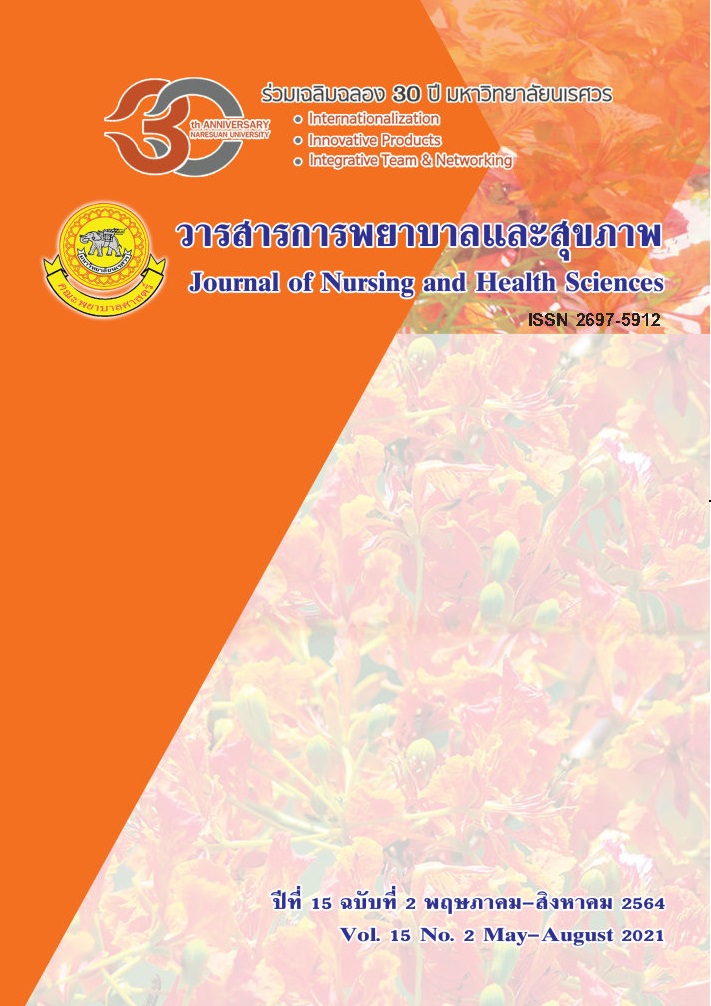Application of self-management concepts in Nursing Clinical Practice: A Case Study Diabetic Patient with Nephropathy
Main Article Content
Abstract
Patients with diabetes often have nephropathy, which especially found the large numbers in stages III and IV, which was the period of showing signs and symptoms and found abnormalities in blood and urine testing. It was found that the prevalence of diabetic nephropathy was up to 45.5 %, with 34.5% in stage III and 39.5% in stage IV (Janjumras & Pipatsatitpong, 2016). This evidence shows nephropathy control is still a problem. It caused by uncontrolling blood sugar and having long periods of high blood sugar levels, which lead to changing in small blood vessels of kidneys, following by losing kidney function and permanent kidney pathology. This problem can affect the physical, mental, emotional, social, and economic aspects of patients. Therefore, it is necessary that nurses should promote appropriate behavioral adjustment and self-management to delay the progression or extend the period of development to end-stage renal disease. This article aims to presents concept and the application of using the Kanfer’s self- management theory to nursing care for diabetic patients with nephropathy. The results of applying this theory may help the patients-participated in the management of health problems can change their self-management behavior appropriately correspondent with lifestyle and needs that can slow down the progression of the disease or extending the development period to end-stage renal disease.
Article Details

This work is licensed under a Creative Commons Attribution-NonCommercial-NoDerivatives 4.0 International License.
References
Aekplakorn, W., Chariyalertsak, S., Kessomboon, P.,
Assanangkornchai, S., Taneepanichskul, S., &
Putwatana, P. (2018). Prevalence of diabetes
and relationship with socioeconomic status in
the Thai population: national health examination
survey, 2004-2014. Journal of diabetes research,
, 1-8. doi.org/10.1155/2018/1654530.
American Diabetes Association .(2016). American
diabetes association standards of medical care
in diabetes-2020. The journal of clinical and
applied research and education, 43(1).
Buathongkhamwisat, P., Pinchaleaw, D., & Moolsart,
S. (2017). The Effectiveness of Self-Management
Program on Type 2 Diabetic Patients in Thakor,
Maesuaidistrict, Chiangrai Province. Journal of
The Police Nurses, 9(1), 105-116.[in Thai].
Damnok, K. & Daenseekaew, S. (2017). Self-Management in Diabetic Nephropathy Prevention among
People with Diabetes. Journal of Nursing and
Health Care, 35(1), 91-99. [in Thai].
Division of Non CommunicableDepartment disease
control Disease of Ministry of public health.
(2020). Number and rate of morbidity/ mortality
year 2016-2019. Retrieved 15 February 2020
fromhttp://thaincd.com/2016/mission/documentsdetail.php?id=13893&tid=32&gid=1-020.
[in Thai].
Janjumras, K. & Pipatsatitpong, D.(2016). Prevalence
of Diabetic Nephropathy in Type 2 Diabetes
Mellitus at Somdejprapinklao Hospital. Prevalence
of Diabetic Nephropathy in Type 2 Diabetes
Mellitus at Somdejprapinklao Hospital. J
Med Tech Assoc Thailand, 44(1), 5508-5521.
[in Thai].
Jirubapa, M. (2014). The Slowly Progressive Chronic
Kidney Disease from Adult to Elder Persons.
The Journal of Boromarajonani College of
Nursing, Nakhonratchasima, 20(2), 5-16. [in Thai].
Juntachat, A., Meepan, M., & Jabprapai, P. (2017).
The Development of The Self-Management
Program for Diabetes mellitus patients with
third stage Chronic Kidney Disease. Journal of
Preventive Medicine Association of Thailand, 7(3),
-291. [in Thai].
International Diabetes Federation (IDF). (2019). IDF
Diabetes Atlas Ninth edition 2019. Retrieved 15
February 2020 fromwww.diabetesatlas.org.
ISBN: 978-2-930229-87-4
Kanfer, F. H. (1980). Self-management methods. In
F. H. Kanfer, & A. P. Goldstein (Eds.), Helping
people change: A textbook of medthods (2nd ed).
New York: Pergamon press.
Kuljitjuerwong, S. (2013). LINE-Communicating
format on the creativity of Smartphone: Benefits
and limits of application. Executive Journal, 33(4),
-54. [in Thai].
Photatong, S. (2011). Effects of self-management
Program on Self-management Behaviors and
Clinical Indicator among Patients with Diabetic
Nephropathy (Master of Nursing Science Thesis
in Adult Nursing). Graduate School, KhonKaen
University. [in Thai].
Poomsalood, N., & Satirapoj B. (2016). Long-term
Follow-up of Decline Glomerular Filtration
Rate in Type 2 Diabetic Patients. Royal Thai
Army Medical Journal, 69(4), 159-166. [in Thai].
Sanee, A. (2014). Self Management Program in
Chronic Diseases. Journal of The Royal Thai
Army Nurses, 15(2), 129-134. [in Thai].
Satirapoj B, Adler SG. Prevalence and Management
of Diabetic Nephropathy in Western Countries.
Kidney Dis (Basel) 2015;1: 61-70.
Srichongchai, S., Tachavijitjaru, C., Pankra, S., &
Wanichpanjapol, W. (2020). The Roles of
Nurses to Delay The Progression of Chronic
Kidney Disease among Diabetic Patients
Type 2. Journal of Nursing and Health Sciences,
, 1-9. [in Thai].
The Nephrology Society of Thailand. (2020). Thailand
Renal Replacement Therapy Year 2016-2019.
Retrieved 15 February 2020 from https://
www.nephrothai.org/annual-report-thailandrenal-replacement-therapy-2007-2019-th/
Varitsakul, R. (2014). Dietary management for slow
progression in patients with diabetic kidney
disease. Journal of The Royal Thai Army
Nurses, 15(1), 22-28. [in Thai].


